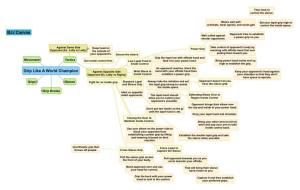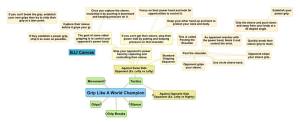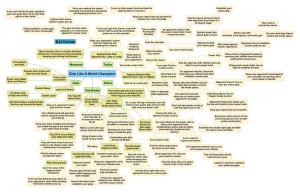In competition, all matches start on the feet, and it’s illegal to pull without contact. That means that the grip battle is an element of every match.
It’s also happens to be an area of study that is often neglected. I know I’ve neglected it, but there’s no time like the present to rectify that. That’s why I’m studying Jimmy Pedro’s Grip Like a World Champion DVD. It hones in on that topic like a laser, and it introduces elements of the grip battle that are uncommon in Jiu-jitsu.
Recently I spent some time slowly dissecting the material, and these are my notes. My goal in sharing is to help anyone else that is interested in the topic. And even if words aren’t enough to help you visualize, maybe it’ll inspire you to take advantage of all the other resources that are available. For example, Jimmy Pedro is still selling this DVD on his site and Rhadi Ferguson focuses on the topic..
Overview
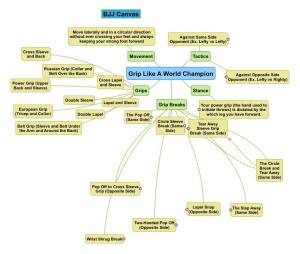
- Stance
- The leg you have forward dictates your power hand. So for example, if your right leg is forward, your right hand will be your power hand, and you will use it to initiate most of your throws.
- Movement
- If you play left, always keep your left leg forward.
- Always maintain at least six inches between your feet as you move.
- Only cross your feet during the initiation of an attack.
- Grips
- Lapel and Sleeve
- Cross Lapel and Sleeve
- Double Lapel
- Double Sleeve
- Cross Sleeve and Back
- Russian Grip (Collar and Belt Over the Back)
- Power Grip (Upper Back and Sleeve)
- European Grip (Tricep and Collar)
- Belt Grip (Sleeve and Belt Under the Arm and Around the Back)
- Grip Breaks
- The Pop Off (Same Side)
- Pop Off to Cross Sleeve (Opposite Side)
- Two Handed Pop Off (Opposite Side)
- Circle Sleeve Break (Same Side)
- Tear Away Sleeve Grip Break (Same Side)
- The Circle and Tear Away Sleeve Break (Same Side
- The Lapel Snap (Opposite Side)
- The Slap Away (Same Side)
- Wrist Shrug Break
- Tactics
- Against Same Sided Opponents
- Objective
- Standard Gripping Sequence
- Against Opposite Sided Opponents
- Objective
- Gripping Sequences
- Against Same Sided Opponents
Stance
One thing that is really interesting about Grip Like a World Champion is the emphasis on how the situation changes depending on stances. If you play left handed and your opponent is a lefty too, you’re mirroring each other and you have a certain amount of good options.
On the other hand, if your opponent is a righty, you’re opposite, and that is a different situation.
It hammers in the idea that you have to pay attention to stance because it will determine how you must play the game.
Movement
Being mobile without unintentionally changing your stance is an attribute is shared between a wide variety of martial arts. You have to be able to move forward, back, lateral and circular all while maintaining stance.
It’s always good to be reminded of that. Repetition is the mother of skill.
Grips
The lapel and sleeve grip is the most common combination I’ve seen in Jiu-jitsu, but we don’t have to be limited to just that. Personally, I like the cross sleeve/back and power grips a lot, and I’ve had success with them.
The other grips are interesting though, and once you start thinking about grip variations, it opens up a whole new world of possibility.
Grip Breaks
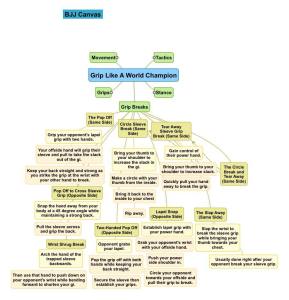 (From this point on, I’m going to assume that you’re right handed. It will make these notes easier to explain.)
(From this point on, I’m going to assume that you’re right handed. It will make these notes easier to explain.)
- The Pop Off (Same Side)
- (Your opponent grips your lapel with their right hand.)
- Grip their right sleeve with your left hand and pull to remove any slack.
- Strike their grip at the wrist with your right hand while keeping your back straight to break.
- Pop Off to Cross Sleeve (Opposite Side)
- (Same principle as the first Pop Off.)
- Snap the hand away from your body at a 45 degree angle while maintaining a strong back.
- Pull sleeve across your body and grip their back with your right hand.
- Two Handed Pop Off (Opposite Side)
- (Your opponent grips your lapel with their left hand.)
- Pop the grip off with both of your hands while keeping your back straight.
- Secure their sleeve then establish dominant grips.
- Circle Sleeve Break (Same Side)
- Bring your left thumb to your shoulder to increase the slack in the gi.
- Make a circle with your left thumb from the outside.
- Bring it back inside to your chest.
- Rip away.
- Tear Away Sleeve Grip Break (Same Side)
- Gain control of their right hand.
- Bring your left thumb to your shoulder to increase the slack.
- Quickly pull your left hand away to break the grip.
- The Circle and Tear Away Sleeve Break (Same Side)
- Attempt the circle sleeve break.
- Tear away immediately if the circle break fails.
- The Lapel Snap (Opposite Side)
- Establish lapel grip with your right hand.
- Grab your opponent’s left wrist with your left hand.
- Push your right shoulder in.
- Circle your opponent towards your left and pull their grip across to break.
- The Slap Away (Same Side)
- Slap their left wrist to break the sleeve grip while bringing your right thumb towards your chest. (Usually done right after your opponent breaks your sleeve grip.)
- Wrist Shrug Break
- Arch the hand of your trapped sleeve backwards,
- Then use that hand to push down on your opponent’s wrist while straightening your back and stretching away to shorten your gi.
Opposite Stance Tactics
Objective
The opposite stance battle is a fight for inside control. Whoever controls that inside space is more dominant and has more options.
It’s harder to completely neutralize a power grip though. That may be the reason why more time was spent focused on countermeasures for this type of battle.
Gripping Sequences
- Lapel and Sleeve Grip (Ideal vs opposite sided opponents)
- Always take the initiative and set your lapel grip strong to control the inside space.
- Your lapel grip should allow you to control your opponent’s shoulder.
- Don’t put two hands on the gi until the lapel grip is set.
- Low Lapel Feed to Inside Control
- Grip the lapel low with your left hand and feed it to your right.
- Wrist Block to Inside Control
- As your opponent reaches, block their left hand with your left then establish a power grip.
- Power Grip (Well suited for shorter opponents)
- Reach out and grip your opponent with your left hand.
- Pull them in.
- Bring your right hand inside their arms and up high to establish the grip.
- Keep your opponent’s head against your shoulder so that they don’t have space to operate.
- Cross Sleeve Grip (An unorthodox grip that throws people off)
- Pull the sleeve grip across the front of your body.
- Bend opponent over and use your head for control.
- Grip the back with your right hand to lock in the control.
- Cross Lapel to Capture the Sleeve
- Pull your opponent toward you as you circle towards your left.
- That will bring their right hand closer to you.
- Capture it and then establish your preferred grips.
- Defending Elbow Over to Regain Inside Control
- (Your opponent brings their elbow over the top and inside of your right arm.)
- Drop your right shoulder to bring your elbow under theirs.
- Bring your left hand up to hit their wrist as you pop your arm straight to take back inside control.
- Closing the Door to Maintain Inside Control
- Use right elbow to block your opponent from establishing a power grip.
Mirror Stance Tactics
Objective
When it playing against someone that mirrors you, the primary objective to prevent them from grip your gi with their power hand. So if you’re a righty, the focus is on controlling their right hand.
If you can’t do that the second best option is to use your left hand to post against that right shoulder. It’s a form a distance control, and it will make it harder for them to grip you.
On the flip side, your opponent has the same goal as you. So you have to keep your right arm in a strong position until you’re ready to establish your grips.
So the mirror stance grip battle is relatively simple. It’s a fight for the establishment and maintenance of power grips.
Gripping Sequence
- Standard Sequence
- Post your left hand on their shoulder.
- As your opponent reaches with their right hand, block it.
- Grip their right sleeve and push it down and away from your body at a 45 degree angle.
- Establish your power grip
The Full Map
Want to hear something crazy? All that came from a 31 minute video….

